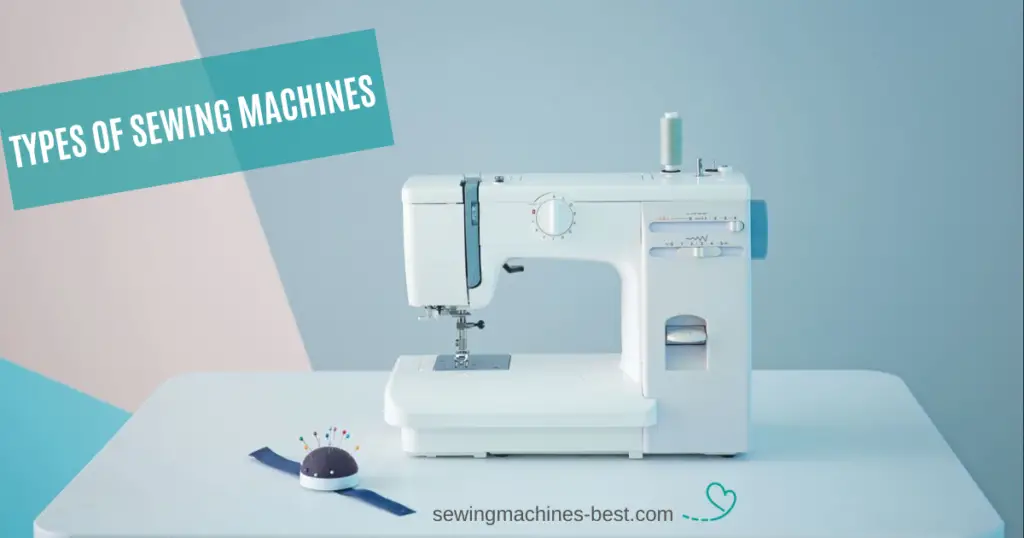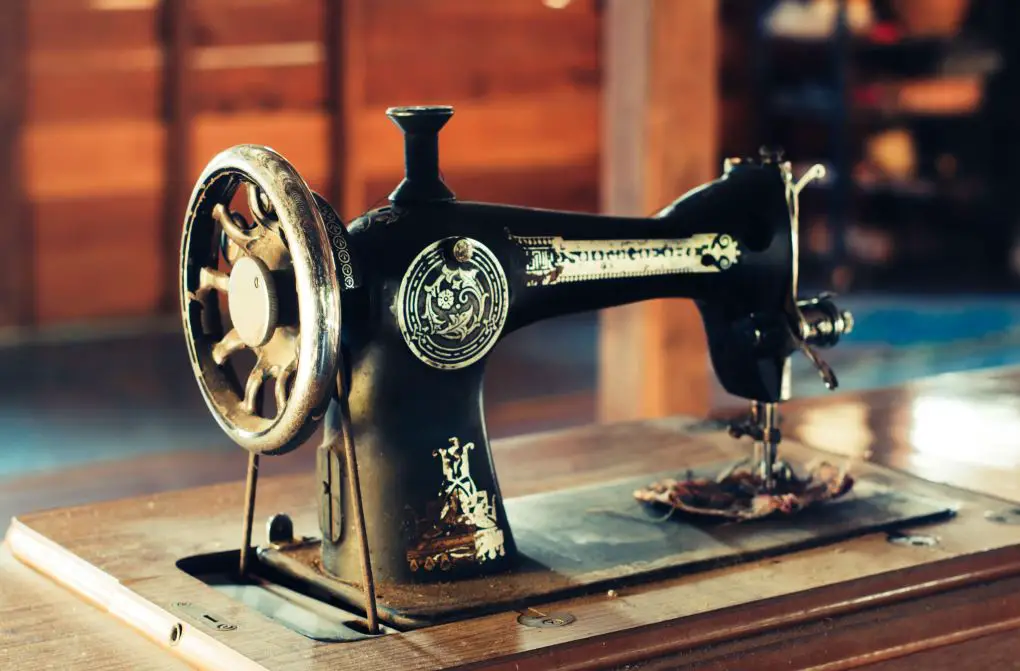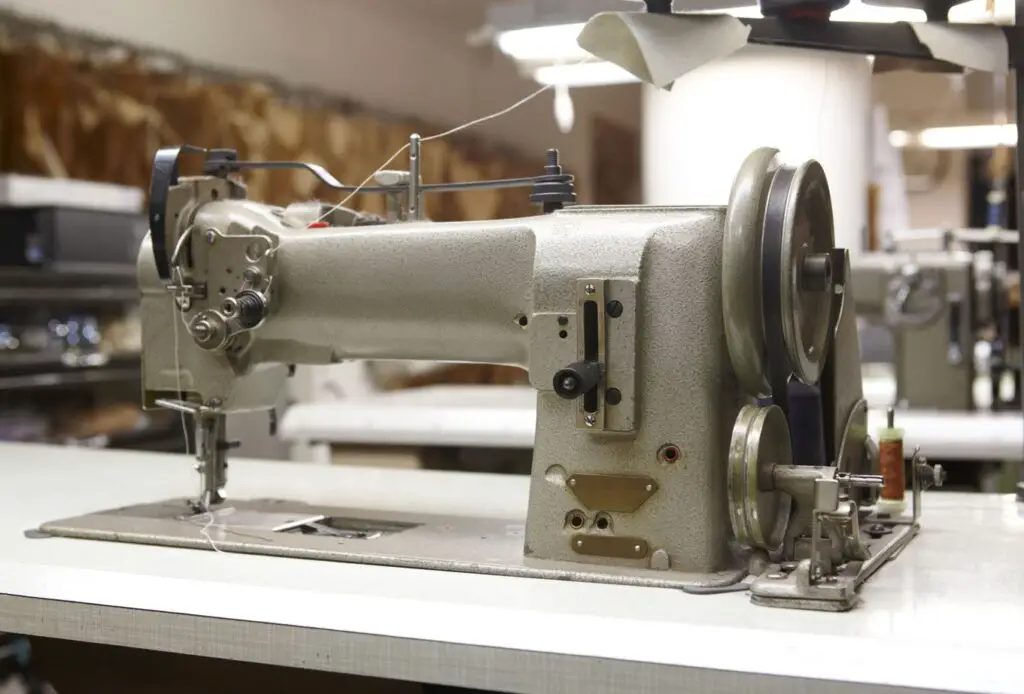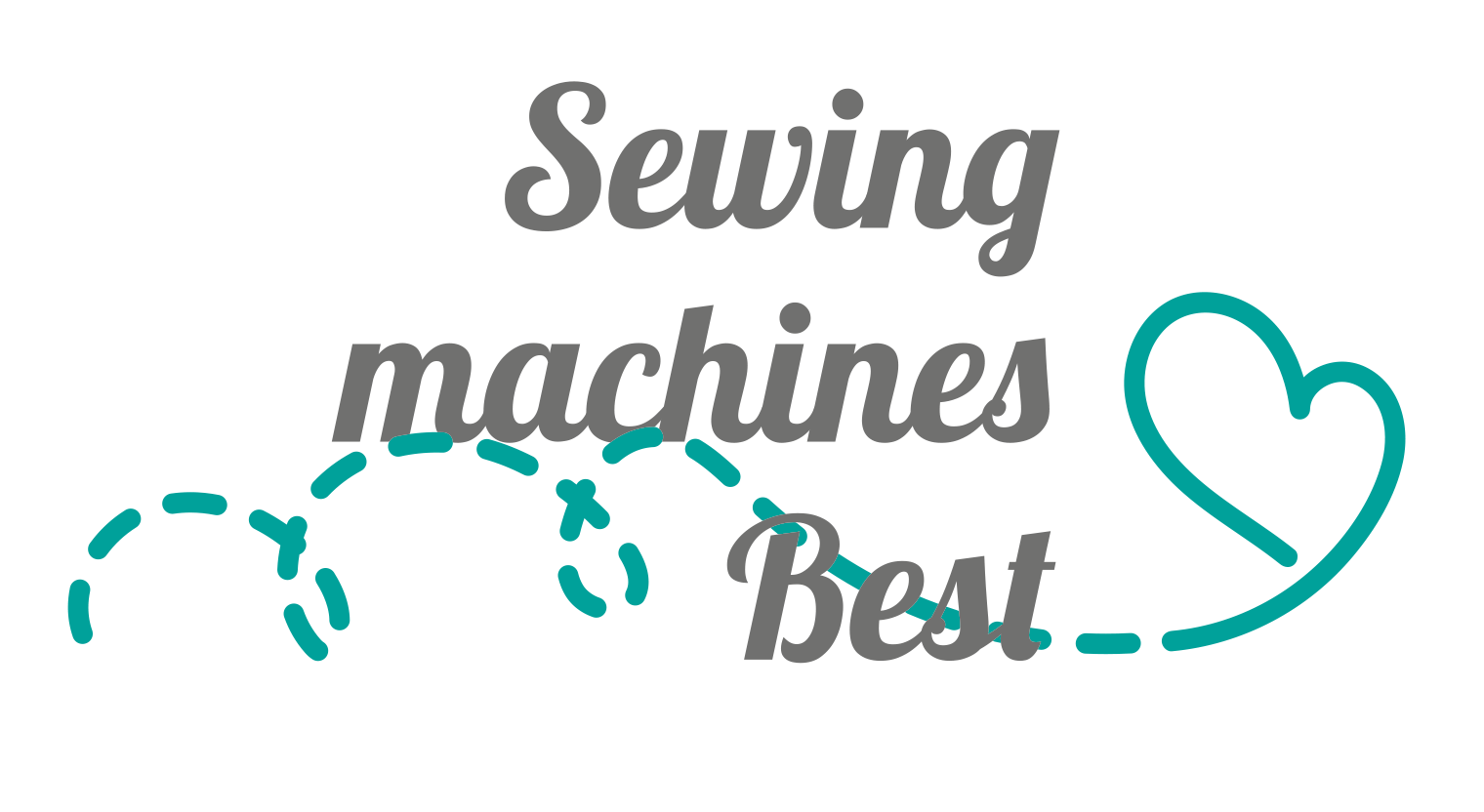
Just like with any other piece of machinery or hardware, there are a lot of models designed for multiple purposes. Sewing machines also follow this pattern. Given that sewing is related to many different operations (like neating the raw ends, sewing buttons, performing many different types of stitches, etc.), it was inevitable to have a wide choice of sewing machines for all purposes and at all prices. In the following post, I want to show 17 different types of sewing machines and their uses and explain what’s the difference between them.
Contents
- 1 What’s the difference between a domestic and an industrial sewing machine?
- 2 Types of Domestic Sewing Machines
- 3 Industrial Sewing Machines
- 3.1 Heavy Duty Sewing Machine or Leather Sewing Machine
- 3.2 Serger Sewing Machine
- 3.3 Flatlock or Cover Stitch Machine
- 3.4 Lockstitch Sewing Machine
- 3.5 Chain Stitch Machine
- 3.6 Blind Stitch Machine
- 3.7 Button Sewing Machine
- 3.8 Buttonhole Machine
- 3.9 Bar Tack Sewing Machine
- 3.10 Safety Stitch Machine
- 3.11 Flat Seam Machine
- 4 What is the right sewing machine for me?
- 5 Conclusion
What’s the difference between a domestic and an industrial sewing machine?
The main difference between a domestic and an industrial sewing machine is the purpose of use. A domestic sewing machine is used for home sewing from time to time, so there’s no big need for heavy-duty construction or many complicated features.
Industrial sewing machines, on the other hand, must work for a long time during the day. The other reason for using industrial sewing machines is that many tailor workshops (or even garment factories) work with many different materials. Some of them are difficult to work with (like leather or plastic). So there’s a need for sewing machines with sturdy construction.
Types of Domestic Sewing Machines
Manual Sewing Machine (treadle)

Manual sewing machines are the oldest type of mass-produced sewing machines. Maybe your grandma or auntie had one. Most treadle models are made of metal. The main principle of work for this type is working the treadle plate below the machine which is usually just above the floor. There are also machines using a wheel that is driven manually.
Speaking of manual sewing machines, the biggest difference between them and most modern sewers is that treadle sewing machines don’t need electricity for work. Some people may consider it an advantage, but this one is mostly obsolete even for remote rural areas now. However, this kind of machine can be the ideal addition to your antique collection.
Mechanical Sewing Machine
This kind of sewing machine is a step up from treadle sewing machines. They are more compact and simple to use. Their main difference is that it uses analog knobs or buttons for control, most large models have a foot pedal, too.
It’s not the most advanced type of machine, but it is very versatile if all you need is just to perform basic operations like standard stitches. Another big advantage of mechanical sewing machines is their durability. This is a great all-around sewing machine type for use at home or in a small workshop.
Electronic Sewing Machine and Computerized Sewing Machine
These two types of sewing machines are way more advanced than mechanical sewing machines. They are more flexible and offer the owner a lot of options: they can straight stitch, zig zag stitch and some advanced programmable models are capable of making button-holes. Computerized sewing machines and electronic sewing machines are well-known for their durability and high quality of post-sale maintenance (including tutorials). No surprise these types of sewing machines are in great demand now. Early electronic sewing machines were infamous for the low quality of electronics and software but now most problems are solved.
Embroidery Machine
Embroidery is often associated with hand sewing. But it can be performed with a sewing machine, too!
Embroidery sewing machines give the owner unlimited freedom of self-expression. It can range from simple built-in designs, which can be useful for starters, to really complicated ones. USB port for downloading the embroidering patterns is also very useful for people interested in handicraft. Most embroidery sewers are high-end models, but it’s not surprising.
Quilting Sewing Machine
This type of sewing machine is used for quilting operations. A longer arm allows operations with larger and thicker fabrics. Speaking of sewing programs, one of the main features of quilting sewing machines is the programmable needle up/needle down feature which is very useful for patchwork. Some brands (like Janome) produce sewing machines suitable for general and quilting sewing.
Mini Sewing Machine and Portable Sewing Machine
Portable sewers are the most popular sewing machine type today. There are good reasons for it: they are reasonably priced, they have great portability (as the name suggests), and they are easy to work with and set up. Of course, they are stripped of state-of-art features, but most domestic machines don’t need them. Having a durable and portable sewer with you may be more important than features you will never use.
The main drawbacks are the poor quality of many models, particularly the cheapest ones from unreliable manufacturers.
Industrial Sewing Machines

Heavy Duty Sewing Machine or Leather Sewing Machine
Besides domestic sewing machines, there are other types of sewing machines called industrial sewing machines. The working principles of an industrial sewing machine are similar to a domestic sewing machine. However, they should have different features and characteristics, since they are designed for different purposes.
Let’s take a look at sewing machines suited for work with leather. Since leather is tough and sticky material, tailors need a walking foot on their sewing machines. Walking foot is needed for gliding over leather and stitching garments, shoes, bags, etc. A powerful electric motor is also needed for sewing machines used for work with leather.
Serger Sewing Machine
A serger or how it is also called an overlock machine is a universal sewing machine used for making durable seams, they are used for sewing hems and finishing fabric edges. Sergers are also very good for working with knit fabrics like the fabric used for sportswear. Most sergers have three or four threads.
A big advantage of serger machines is the possibility of performing the edge neating and seam closing at the same time with one stitching. But you must keep in mind that sergers are best suited for more experienced sewers. Serger sewing machines are more expensive than simple domestic sewing machines, but their versatility and flexibility are worth their price.
Flatlock or Cover Stitch Machine
These sewing machines are used for working with knit and stretch fabrics. Furthermore, as implied by their name, they are applied for sewing cover stitches. They give the owner a lot of possibilities, they can be used to add decorative elements, bind, hem, or topstitch. Unlike the overlocker, the cover stitch sewing machine doesn’t have blades. But it doesn’t mean that this machine type is useless. If you work with knit fabric and create for example sportswear a cover stitch machine is good to have. Coverstitch uses one to three needles depending on the strength and the stitch you need.
Lockstitch Sewing Machine
A lockstitch machine is designed for creating straight and zig zag stitches. Lockstitch is a stitch that consists of two threads. One thread is on the top, while the other is on the bobbin, the machine interlocks them before they actually go through the hole made in the fabric. These sewing machines make stitches that look identical on both sides of the fabric. These stitches can also be adjusted in their length.
Speaking of business use, there are heavy-duty modifications for many models of lockstitch machines. These modifications are very important for excessive business use.
Chain Stitch Machine
Chain stitch sewing machines are used for creating a chain stitch. A chain stitch looks like a chain and is created of a series of stitches that are looped together, mostly this kind of stitch is often used to hem jeans.
Speaking of variety, there are chain stitch machine models with one needle or two needles, and one thread or two threads (the latter are called double chain stitch machines).
Blind Stitch Machine
This type of sewing machine is used for creating invisible stitches for example on hems. It has not many uses besides it, but it is an irreplaceable tool for creating this kind of stitch. The most special part of this machine is the presser foot which keeps the raw edge pressed.
Button Sewing Machine
As the name suggests, this sewing machine type is suited for sewing buttons into the garment very quickly. The main feature of this type is the ability to switch between different types of buttons (flat, shank, hook, etc.). While not necessary for home use, this sewing machine type is very important for big tailor workshops.
Buttonhole Machine
Buttonhole sewing machines are industrial machines designed for making a lot of buttonholes per hour. A lot of home sewing machines also have this feature, which is very comfortable. You may not need a buttonhole machine for home use, but it is irreplaceable for high-volume manufacturing.
Bar Tack Sewing Machine
Bar tacking is a sewing technique used to reinforce fabrics, making them more durable. Bar tack machine can be used for sewing items and areas that wear and tear most like joints of belt loops, ends of zippers, places around buttonholes, etc. It can be useful for a workshop, although most general-purpose sewing machines are able to make bar tacking.
Safety Stitch Machine
Safety Stitch machines are used to create clean seams or neaten up edges. Most sergers are able of this, but safety stitch machines are often sold as stand-alone devices. Most safety stitch machines are capable of performing two-thread chain stitch and three-thread overlock stitch.
Flat Seam Machine
Flat seam sewing machines come in two types: one with a flatbed and the other with a cylindrical bed. Binding cut edges and stitching flat seams on knit fabrics are the principal applications for this kind of sewing machine.
What is the right sewing machine for me?
Well, you must know what you want from your future sewing machine. If all you need is just repairing your clothes from time to time, you don’t need one of the most advanced and expensive embroidery machines.
But if you want to create a workshop with large-scale production, you will need a lot of machines with different purposes since there will be many operations. And, of course, NEVER use domestic sewing machines for large-scale production. Domestic machines are not designed for constant use, so using one in the workshop will break it quickly.
What you also have to keep in mind is your experience. If you consider buying a domestic sewing machine, ask yourself first: “Am I ready for working on this machine?” If you are a newbie in sewing, you don’t need a complicated high-end computerized sewing machine. Thankfully, there are a lot of lessons and tutorials online. Nowadays, people who want to improve their sewing skills can choose from a broad variety of lessons and tutorials online and offline.
But if you already have a lot of experience, you want to further develop and improve your skills and also try new techniques, then it would be time for an advanced sewing machine.
Another important principle in selecting the sewing machine is to know what type of fabric or material you will and want to use. If you work with materials like leather or plastic, you should never buy a domestic sewing machine, since its construction is too vulnerable for such a tough material. Then, you should keep an eye on a heavy-duty machine. Vice-versa, using materials like silk doesn’t require any special work conditions, so buying a lighter sewing machine would be a perfect solution.
And, of course, choosing a sewing machine isn’t different from choosing any other appliance or machinery in terms of checking manufacturers’ specifications and asking about post-sale warranty and maintenance.
Conclusion
As you can see, there are a lot of types of sewing machines. You can choose between many household machines and also between many industrial machines, for example, if you have your own business. I am sure you can find a model perfectly suiting your own needs. But you should remember: nothing is perfect, and you should select a machine relying on your needs and skills. So it will be a perfect piece of machinery for you!
Here I linked a good video about types of sewing machines.

Hi everyone and welcome to my blog!
My name is Liz, and I started sewing when my son was born. First I repaired the holes in children’s pants, then I dared to do more challenging projects like sewing home decor and children’s clothing. Now it is my hobby where I come to rest, let my creativity run wild, and create things that please me and enhance my home.
I would love to help other sewing beginners and enthusiasts through my blog by sharing tips and tricks for this great hobby.

